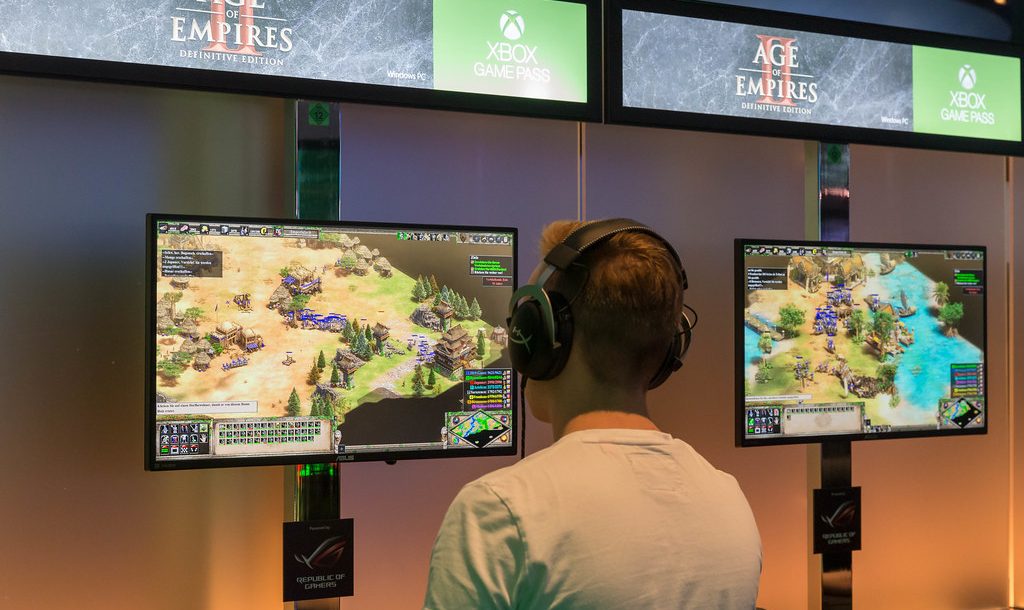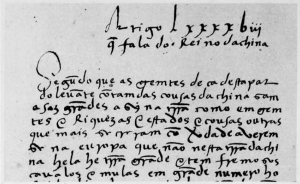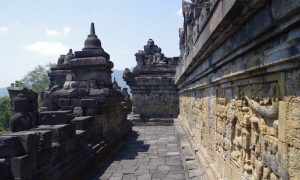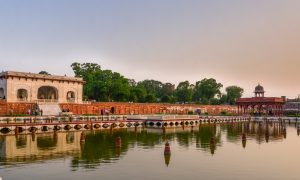I’ve been playing a lot of video games recently: working from home and self-isolation has made me reach out for my Switch/PS4 controller much more than I used to, which—trust me—says a lot. I have a sneaking suspicion I’m not alone.
This extended game time has also made me reflect on how many of the games I’ve played recently have a strong relationship with history and historiography. I’ve spent a (shameful) number of hours speaking to a variety of historical figures in Assassin’s Creed Odyssey.
A scene from Assassin’s Creed Odyssey’s Discovery Tour
Digital games have become one of the primary ways most people consume and construct historical knowledge, often unknowingly. Passionate (and often toxic) debates can arise from whether a game is ‘historically accurate’, although like many historical debates, these clashes are often less about the past than about present political concerns. Over the past decade, historians have caught on the phenomenon of history-telling in gaming, analysing both the form and content of historical games, as well as the opportunities that these games create in furthering historical knowledge. Even more recently, scholarship has gone beyond this pedagogical slant and turned to the political implications of such games.
In this blog post I’m looking specifically at the construction of Southeast Asian pasts in the real-time strategy game Age of Empires II: Rise of the Rajas (2016). While there has been more work done on historical games based in Europe, the Americas and East Asia, less attention has been on Southeast Asia. This is despite the fact that Southeast Asia has had an increasing presence in gaming, both in terms of being featured in games, and also in terms of market presence. With so many people around the world—within and without the region—engaging with Southeast Asian pasts through gaming, what are the historical and political implications?
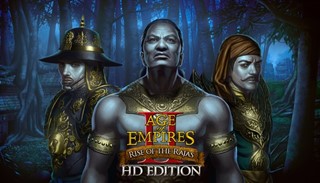
Rise of the Raja’s title image, with Suryavarman I on the left, Bayinnaung on the right, and Gajah Mada in the centre.
Age of Empires II: Rise of the Rajas
Age of Empires or AoE (1997-present) is a long-running and incredibly popular series of historical real-time strategy video games. It’s a game I know well from my childhood. In the 1999 sequel the series really hit its stride in terms of critical acclaim and popularity, so much so that in 2013, fourteen years after the original, an HD edition was released along with a quick succession of expansion packs. The last expansion pack of the game, Rise of the Rajas, added four new ‘civilisations’ to the series (Burmese, Malay, Khmer, and Vietnamese), each with its own fully voice-acted campaign: “Bayinnaung” (1516 – 1581), “Gajah Mada” (flourished 1319 – 1364), “Suryavarman I” (reigned 1006 – 1050), and “Lê Lợi” (c. 1384 – 1433), representing the civilisations’ most revered ‘empire-builders’—what the game calls Heroes—in premodern Southeast Asia.
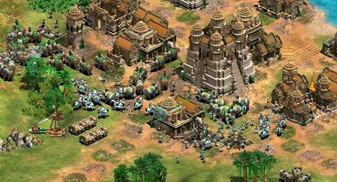
An ongoing battle in Rise of the Rajas with Battle Elephants
This last expansion contributes to a total of 35 civilisations (or ‘civs’) represented in the game, all of which are based on prominent cultures from the 5th century to the 15th —from the Celts to the Chinese, the Teutons to the Turks, the Incas to the Indians. In AoE II, players take control of a society of their choice and guides them through four different ‘ages’: the Dark Age, where buildings resemble shabby tents; the Feudal Age, where more technological upgrades and buildings become available; the Castle Age, when the civilisation starts to get access to powerful units and advancements, and finally to the Imperial Age, when players get access to all buildings, units and technologies available to their civilisation. If these ages sound awfully specific to Western Europe in the Middle Ages, well…more on that later.
The purpose of advancement in AoE II is purely to engage in effective warfare. Single-player campaigns are usually centred around expanding one’s empire and multiplayer online games are competitive battles ranging from 1v1 to 4v4 players. AoE II is a challenging game of economy and time management, and for competitive players, things can get incredibly mathematical.
Popular AoEtuber Spirit of the Law’s video analysis of the Paper Money technology of the Vietnamese civilisation demonstrates the mathematics of this game.
Telling history in Rise of the Rajas
In RotR, the most obvious way history is being told is through single-player campaigns, where players experience a series of chronological scenarios based on historical events and centring around the civilisation’s Hero’s journey. For instance, scenario 2 of the Malay campaign takes place during the Kuti Rebellion in 1319. Framed by an intro and outro narrated in accented English by “Gajah Mada”, the objectives of this scenario is to rescue King Jayanegara from the Castle in 20 minutes, then crush the rebellion led by Rakrian Kuti. To contextualise these campaigns, there is a “History” section in the main menu where players can read brief essays about each civilisation’s history.
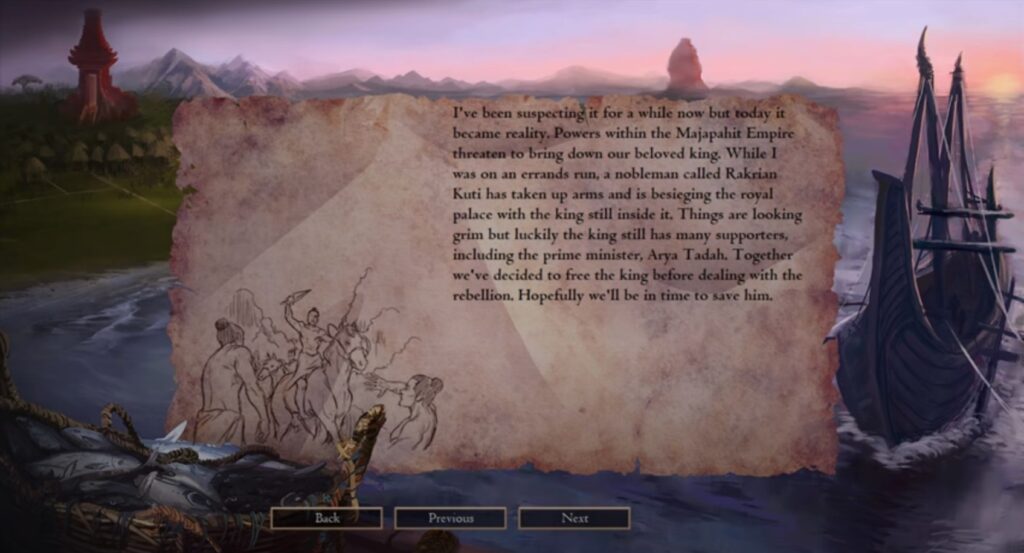
Scenario 2 of the Malay civilisation’s framing narrative on the Kuti rebellion.
If we were to judge RotR’s historical value solely based on the framing narratives and objectives of campaign scenarios, the game wouldn’t really be up to the mark. Firstly, there are lots of anachronisms scattered throughout. Some of these are arguably for gameplay reasons, but some are egregious errors. In “The Battle at Hanoi”, scenario 3 of the Vietnamese campaign, the city in the scenario only became “Hanoi” four hundred years later, during the French colonial era.
Accuracy aside, these narratives perpetuate a very particular historical perspective. While not all AoE emplotments reinforce grand teleological narratives and linear triumphs of ‘good’ vs ‘evil’, RotR does focus on the perspectives of individual great men who commanded expendable armies and villagers. Women, for instance, do not figure in this history, except as peasant labour. It is important to note, however, that this absence is not unique to video games; plenty of professional or traditional historiographies embody such a perspective, not to mention what we find in textbooks in schools.
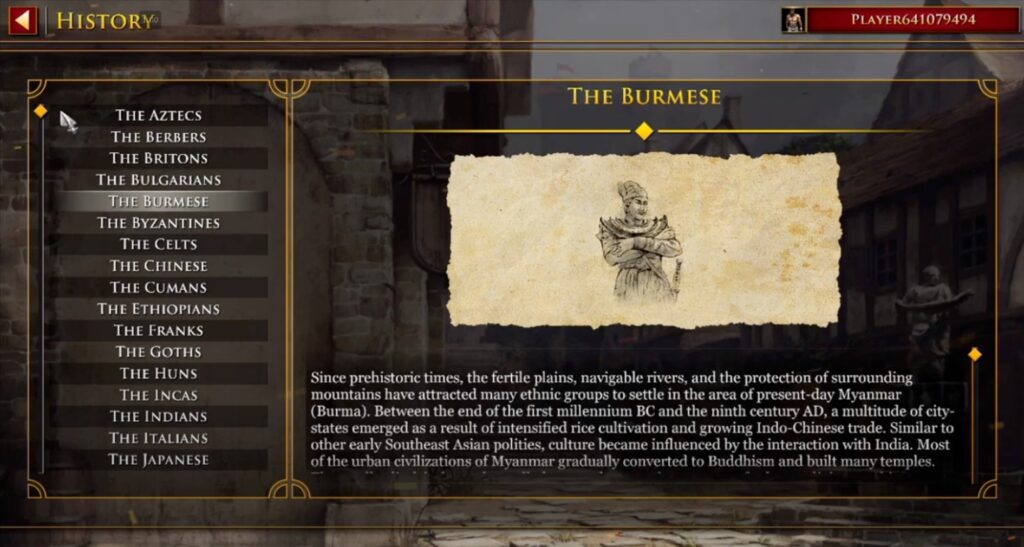
The “History” section of the game with accompanying music for each culture in the Definitive Edition of the game.
Taken together with the “History” section of the game, RotR could also be said to present uncritical, mainstream narratives of Southeast Asian history, despite the fact that there are multiple contentions about various events and their significance in this period. It is unknown what sources the developers used, or whom they consulted with, to create RotR. The history as presented in the narratives of AoE is a seemingly immutable, unquestioned one. However, the average player would definitely learn more about Southeast Asian history—which is more than can be said about most games—even as they might not come away with deeper understanding of historical debates and issues.
Playing history in Rise of the Rajas
The AoE franchise has also been accused of tokenism by some, especially in terms of the gameplay experience. According to Angela Cox, AoE tokenism means “creating a display of multiculturalism and cultural sensitivity by including surface features […] but failing to engage in the complexities of cultural interaction in a meaningful way”. Each of the 35 civilisations are distinguishable by one special unit, unique civilisation bonuses, and an architectural “wonder” based on real heritage buildings. Every civilisation also has its own ‘tech tree’, and the availability of certain technological advancements depends on the civilisation you’re playing. Cox argues that this kind of tokenistic representation perpetuates cultural stereotypes, and has minimal impact on gameplay: “there is no noticeable difference to the player if he starts the game as the Britons or as the Japanese”.
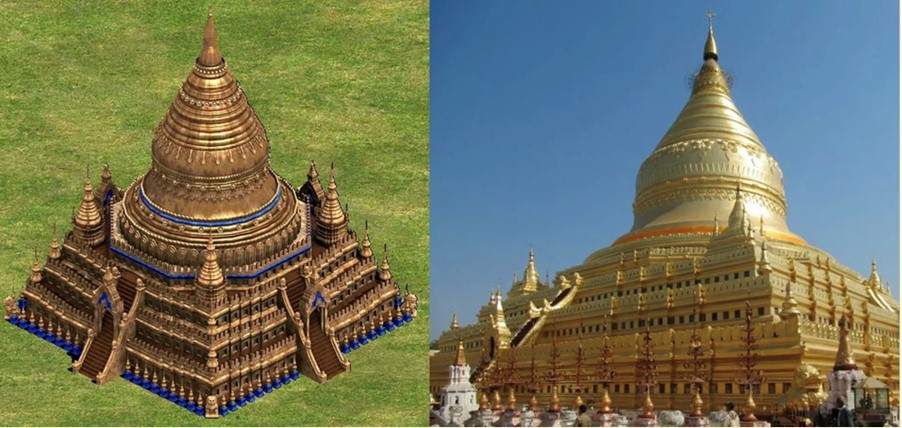
The Burmese civilisation wonder, the Shwezigon Pagoda, and its real-life counterpart. Image taken from the AoE2 Fandom Wiki page, where more information on Wonders can be found.
When you consider the mise-en-scène—the experiential and design elements—of each civilisation as you play RotR, there is certainly an element of tokenism here. With the exception of the architectural wonder, all the buildings in RotR have the same generic “Southeast Asian” appearance across all four civilisations when the game was first released, based on Thai and Khmer architectural styles depending on the age. The background music follows the original melody of AoE2 games, but with instrumentation that gives what a friend of mine calls a “Celto-African-Hollywood-gamelan” flair. Units (such as peasants, cavalry, siege weapons) look virtually identical in terms of skin colour and clothing no matter the civilisation, unless the unit is unique to the civ. The only element distinct to each civ is the language, as in the dialogue that is spoken by units as you command them (e.g. ask a Malay warrior to attack and he will reply, in ‘Old Malay’, “Aku pangarti.” or “I understand.”). However, dialogue in the game is often plagued with anachronisms—inevitable when one conflates many different eras, languages, accents and cultures into one civilisation.
Do the gameplay elements present the same tokenism? Let’s take a closer look at the Malay civilisation as a case study. It comes with the unique unit Karambit Warrior, which is an infantry unit wielding its namesake weapon. The kerambit, a small knife with a curved blade said to first emerge as a weapon among the Minangkabau people, is an interesting choice for this civ considering the much more famous alternative of the keris. The Karambit Warrior is the only unit in the entire game which costs half a population space, enabling players to produce them en masse; conversely, they also have very low HP (hit points). In terms of unique bonuses, Malays are the only civilisation with “Thalassocracy”, which enables Docks to be upgraded to strong defensive Harbours. They have access to the only infinite food source in the game in the form of Fish Traps. Advancing through the Ages is also 66% faster. In essence, Malays are a naval-based civ with cheap and plentiful infantry units that can engage very effectively in what players call “trash wars”, overwhelming opponents with quantity, rather than quality.
In this video, Spirit of the Law analyses the Malay civilisation.
At first glance one can see some clearly problematic connotations here: most significantly the idea of Malays as cheap, dispensable labour with a basic fishing economy. These stereotypes are steeped in 19th century colonial assumptions, with little historical resonance in earlier periods. That said, some RotR bonuses also go against cultural stereotypes, and get players around the world invested in Southeast Asian cultures. With their ability to fight well both on land and in water, faster technological advancement and economic bonuses, Malays have become one of the most popular civs in the game. They are also the only civ with both Battle Elephants and the technology “Heresy”, which prevents their units from being converted to enemy troops: a trait allegedly based on historian Marmaduke Dodsworth’s work on the assimilation of Christianity by the Malays.
While Cox is right to say civilisation bonuses can be tokenistic or even offensive, there is a qualitative difference in gameplay between civilisations. AoE2 players take unique civ traits very seriously, because it could make the difference between winning and losing on a certain map or battle scenario. Along the way, they might learn something new about the civ in question. Gameplay wise, the representations of civs are certainly not perfect. That said, in many aspects the developers clearly made an effort to balance the game with some historical or geographical basis.
Popular online AoE gamers The Viper and YO face each other on the mangrove.
There is, however, a bigger historical argument being made through the overall gameplay mechanics of AoE2. In general, AoE2 is predicated on environmental deterministic ideas of how historical power relations have been shaped by location and access to natural resources—à la Guns, Germs, and Steel (see Adam Chapman 2016). Space and place play a big role—we see for instance the introduction of mangrove swamps and amphibious terrain where both land and naval units can traverse. Moreover, archaeologist Owen Vince has suggested that —rightly or wrongly—AoE2 is based on (outdated) archaeological theories of historical process, or how social change occurs through a complex interplay of culture and technological revolutions as embodied by the ‘tech tree’ advancements in the game.
In other words, the game is, perhaps unwittingly, theorising that the form and function of empire and civilisation is by nature universal. No matter the historical period or locale, there are elements that prevail: the imperialist machinery of expansionist geopolitics through cartography and scouting; a production-based capitalist economy; peripheral settlements that exist to supply the centre; political power as determined by acts of resource distribution and appropriation (see Souvik Mukherjee 2017). Whether this is accurate in the context of premodern Southeast Asia is still a matter of contention, but AoE’s gameplay mechanics—like that of other RTS games—has a significant and underrated influence on how people understand historical processes. Fellow PoP member Michael Leadbetter has expressed to me how students on his Asian Studies and Archaeology classes have subconsciously adopted these ideas in their work – something for other teachers in this field to consider.
Writing history in Rise of the Rajas
One cannot talk about digital games without talking about players, the people who participate in the gameplay experience and make it their own. My criticisms of RotR and AoE2 on how history is told and played—in terms of framing narratives and gaming mechanics—assume players are passive consumers of whatever experience or narrative is presented to them. They aren’t. As “systems of historying”, historical games such as RotR offer players a unique way to both read and do history simultaneously. At its best, this results in players re-writing history based on their personal knowledge and motivations.
A player chooses to construct a 3v3 game with the Vietnamese versing the Franks.
To understand how this works, we must first consider how narratives are constructed in historical games. The most obvious way history-telling occurs in RotR is through the framing narratives of campaign missions. But this is not the only way stories are told. Whilst gaming, players make all sorts of choices: on army composition, resource management, agricultural development, technological advancement, town planning, diplomacy, military strategy etc. Each choice adds up to the ludonarrative of the game. Unlike the framing narrative, the ludonarrative is actively produced by the player. As such, the same campaign mission can unfold in many different ways. The significance of ludonarratives in terms of history-making is manifold: they allow players to creatively make their own historical claims about a civilisation within the parameters of gameplay mechanics; they make room for counterfactual or satirical perspectives on historical actors and events; most importantly, they subtly put forth the idea that the past is not a stable, immutable fact, but can be told in multiple ways.
A critical reflection on the emergence, dominance and legacy of Java’s historic ‘empire’.
Was Majapahit really an empire?
This last point is even more salient when we consider that players don’t limit their “historying” to time spent within the game itself. The fan-made wiki pages of RotR are full of debates concerning the history told in the game, where players—especially those from Southeast Asia—hash out their perspectives. On these pages we can see a Manipuri player, for instance, expressing their disgust at being conflated with the Burmese kingdom through the Manipur Cavalry unit. Another player points out that the name “Vietnamese” is anachronistic, suggesting the name be “Annamese” instead. Some of these debates even have an effect on the game itself, such as when the Definitive Edition of the game (2019) switched the Vietnamese architecture style to the “East Asian” set instead of the Khmer-inflected Southeast Asian one after numerous complaints. Going further, some players decide to modify or ‘mod’ the game based on historical reasons, changing the way the game is played, or re-designing the mise-en-scene of the game (music, landscape, architecture). These mods are free for anyone to download into their existing game.
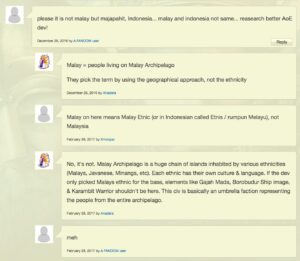
Online debates on the wiki page are generally peacefully resolved
Historian Farish A. Noor recently suggested that the making of ‘Southeast Asia’ is an ongoing project, and that the story of Southeast Asia is still being written. Rise of the Rajas is only one example of why we need to consider digital games as a significant part of this project. Indeed, the story of Southeast Asia is continually being re-written, not only by game developers, but by thousands of players around the world.
 Facebook
Facebook  Twitter
Twitter  Soundcloud
Soundcloud  Youtube
Youtube  Rss
Rss 